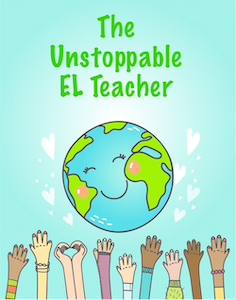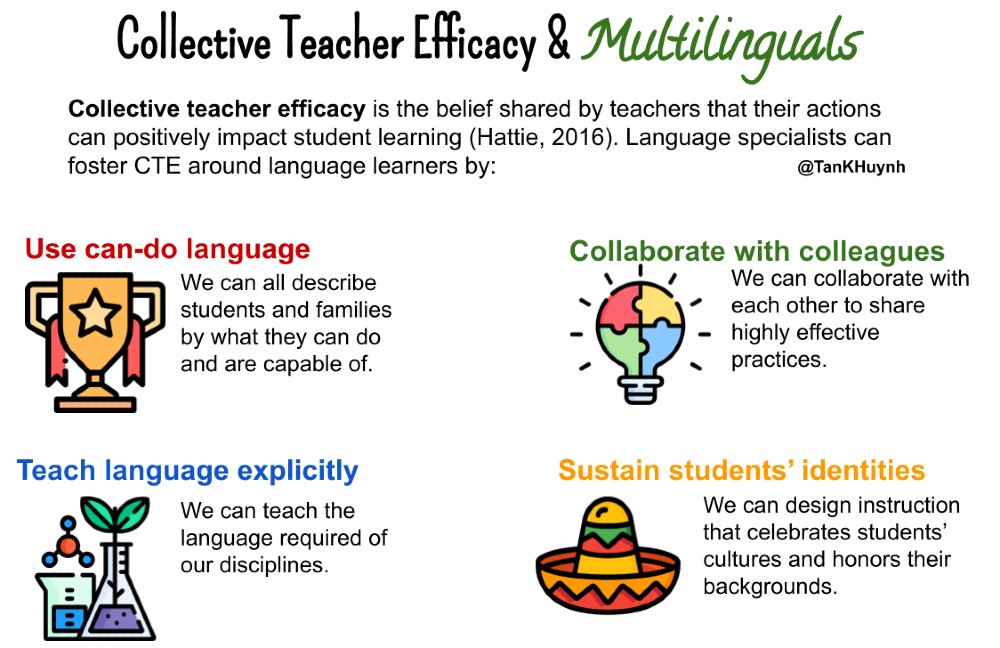MLs Thrive on Collective Teacher Efficacy
A MiddleWeb Blog
 The days of warehousing multilinguals (MLs) in segregated classes separated from the entire school community are thankfully over. It’s now time to unite as a school community to serve our multilingual students.
The days of warehousing multilinguals (MLs) in segregated classes separated from the entire school community are thankfully over. It’s now time to unite as a school community to serve our multilingual students.
Dr. John Hattie suggests that when the staff all share a common belief in their collective action, teachers can positively raise student achievement (2016).
Of all the factors that positively impact student achievement, collective teacher efficacy ranks supreme. According to Hattie’s meta-analyses, one year of learning has an effect size of 0.4, but collective teacher efficacy produces an effect size of 1.57, almost four times greater than simply attending school for a year.
In my podcast conversation with Dr. Hattie, he stressed the value of collaborative conversations among co-teachers and colleagues that help grow a shared belief in what we can do together.
As language specialists, we see firsthand how students are more successful at school when the language specialists and content teachers team up together (Honigsfeld & Dove, 2019). The way to foster a positive collective belief about multilinguals is to use can-do language, collaborate, teach language explicitly, and incorporate asset-based practices.
►Using can-do language
The way we talk about multilinguals reveals how to teach them. In the early part of my career as a language specialist, I only used deficit-based language when talking about multilinguals (e.g., They can’t be expected to learn this; they won’t be able to understand that; they can’t write an essay in English, etc.). However, if we collectively adopt WIDA’s Can Do philosophy (2019) and describe what students and their families can do, our approach becomes more affirming.
Imagine how instruction would change if we used the following statements:
- Students can access grade-level content if we scaffold instruction.
- Students can learn this content using their home language.
- Students can demonstrate their understanding if we provide an alternative format for the end product.
►Collaborating with colleagues
One of the most effective ways to foster a positive belief about the capabilities of multilinguals is through continuous, job-embedded professional learning (Wei et al., 2009). This can take the form of co-planning, co-teaching, co-assessing, and co-reflecting (Honigsfeld & Dove, 2019).
As language specialists spend a year working with their content teacher, the general-education colleague can adopt a sheltered instruction approach to designing lessons (Echevarria, Vogt, & Short, 2016). The content teacher gradually (and ultimately, independently) integrates strategies that make content comprehensible and output achievable (Ferlazzo & Hull-Sypnieski, 2018).
Through consistent collaboration, students will become more successful. With success, content colleagues will start to speak about multilinguals with can-do language and focus on students’ assets instead of being tunnel-visioned by perceived limitations.
►Teaching language explicitly
Each content area has specific rules and language conventions that become invisible if not taught (Cummins & Early, 2015). I remember writing a college science report and describing the layers of sediment being sandwiched between each other. The report came back with the word sandwiched crossed out with an angry red pen and “See me!” written on the margins. Figurative language was not appropriate for a science report, I was told. Linguistic details like that needed to be taught directly by my college professor.
Content teachers are experts in their disciplines. Language specialists can collaborate with content teachers to explicitly teach how to read content-specific texts (Singer, 2018) and write in discipline-specific texts (Fenner & Snyder, 2017).
When every teacher becomes proficient at teaching the language of their discipline, we collectively raise student achievement because students can now read rigorous texts and produce discipline-specific writings.
►Sustaining students’ identities
If we are to raise the achievement of multilinguals, then as a school we must adopt culturally-sustaining practices (Paris et al., 2017). Learning content and acquiring a new language don’t need to come at the cost of students’ connections to their culture.
To ensure that we all sustain students’ identities, we can:
• encourage students to use their home languages;
• form connections between the content and students’ cultural practices & heritage philosophies (e.g., how different cultures interact with the environment and have different religious practices, how the family is structured, how society is organized, etc.);
• ground learning content in a case study based on an aspect of students’ culture.
When teachers intentionally sustain and connect to students’ cultures, identities and backgrounds, students can keep who they are while learning at school. These practices affirm to students that their cultures, their experiences, and their identities are valuable and welcomed in our schools.
As schools become affirming places, students and families will want to engage more and participate in school more fully.
Let’s believe together
Collective teacher efficacy is not a strategy to reduce expectations. It means behaving, speaking, and instructing in specific ways that lead to student achievement. However, these actions cannot be implemented by the language specialists alone. These actions need to be the common practice of everyone in the school for them to blossom into affirming beliefs about our ML students.
If we can successfully do that, then we will have a culture where we collectively believe that our actions can in fact lead students to be exceptionally successful because actions are the fruit of our beliefs. Let’s believe in multilinguals together!
Which of these actions have worked for you and your school, and which ones are you going to work on?
References
Cummins, J. & Early, M. (2015). Big ideas for expanding minds: Teaching English multilinguals across the curriculum. Pearson.
Echevarria, J., Vogt, M., & Short, D. (2016). Making Content Comprehensible for English Learners: The SIOP Model. Pearson.
Fenner, D. S. & Snyder, S. C. (2017). Unlocking English learners′ potential: Strategies for making content accessible. Corwin.
Ferlazzo, L. & Hull-Sypnieski, K. (2018). The ELL teacher’s toolbox: Hundreds of practical ideas to support your students. Jossey-Bass.
Hattie, J. (2016). Third Annual Visible Learning Conference (subtitled Mindframes and Maximizers), Washington, DC, July 11, 2016.
Honigsfeld, A. & Dove, M. G. (2019). Collaborating for English learners: A foundational guide to integrated practices. Corwin.
Paris, D., Alim, H. S., Genishi, C. & Alvermann, D. E. (2017). Culturally sustaining pedagogies: Teaching and learning for justice in a changing world. Teachers College Press.
Singer, T. W. (2018). EL Excellence Every Day: The Flip-to Guide for Differentiating Academic Literacy. Corwin.
Wei, R. C., Darling-Hammond, L., Andree, A., Richardson, N., Orphanos, S. (2009). Professional learning in the learning profession: A status report on teacher development in the United States and abroad. Dallas, TX. National Staff Development Council. https://edpolicy.stanford.edu/sites/default/files/publications/professional-learning-learning-profession-status-report-teacher-development-us-and-abroad.pdf
WIDA. (2019). The WIDA Can Do Philosophy. https://wida.wisc.edu/sites/default/files/resource/WIDA-CanDo-Philosophy.pdf




































